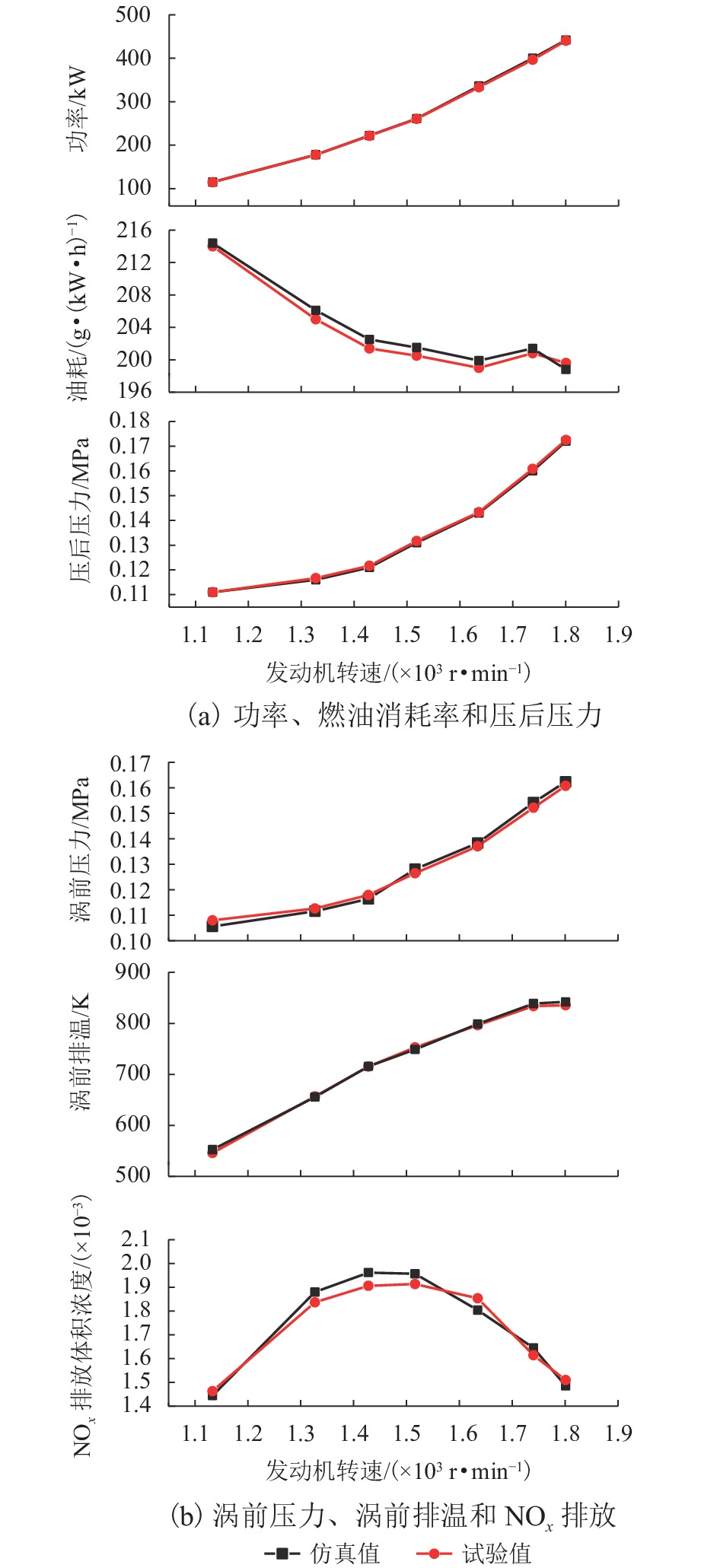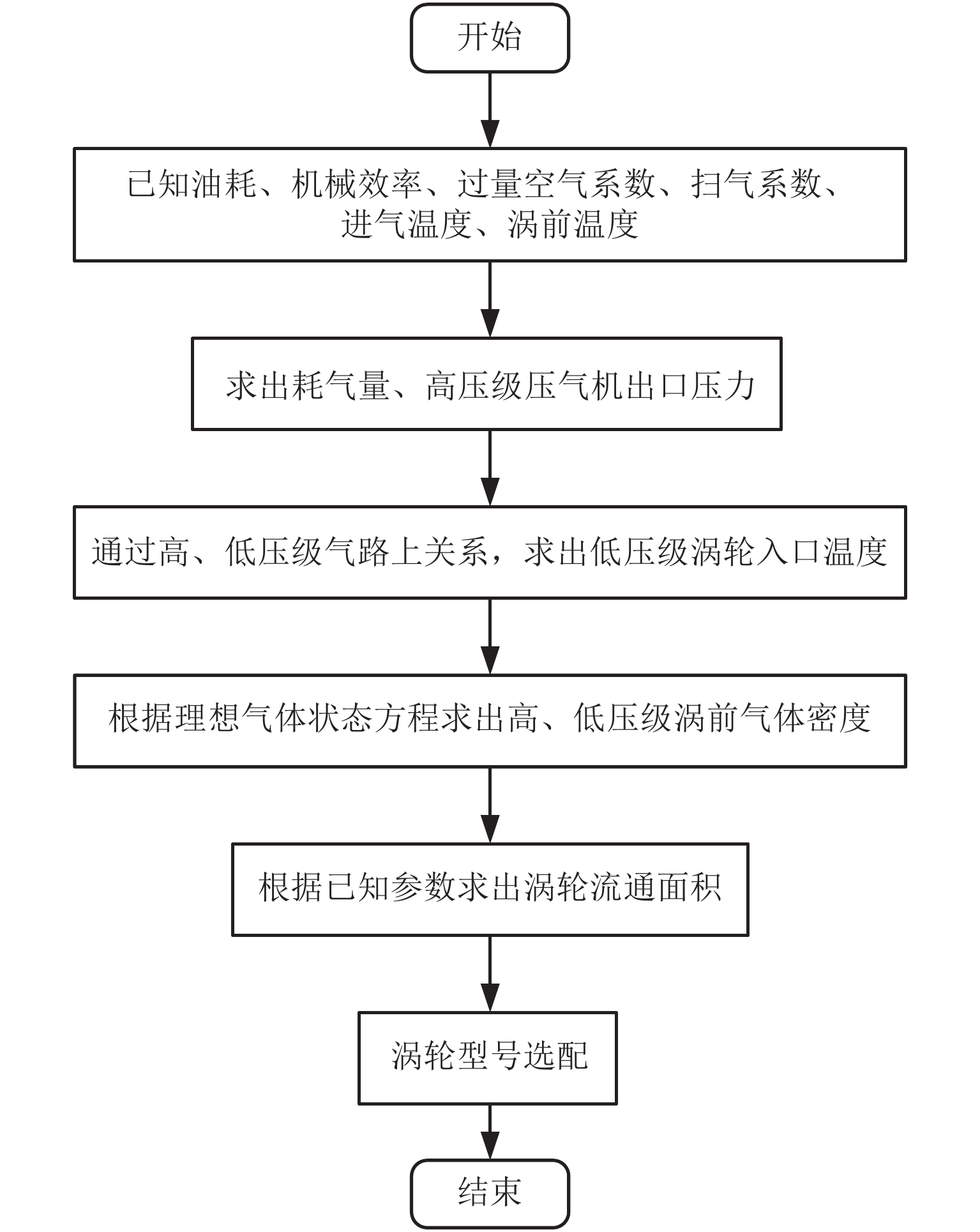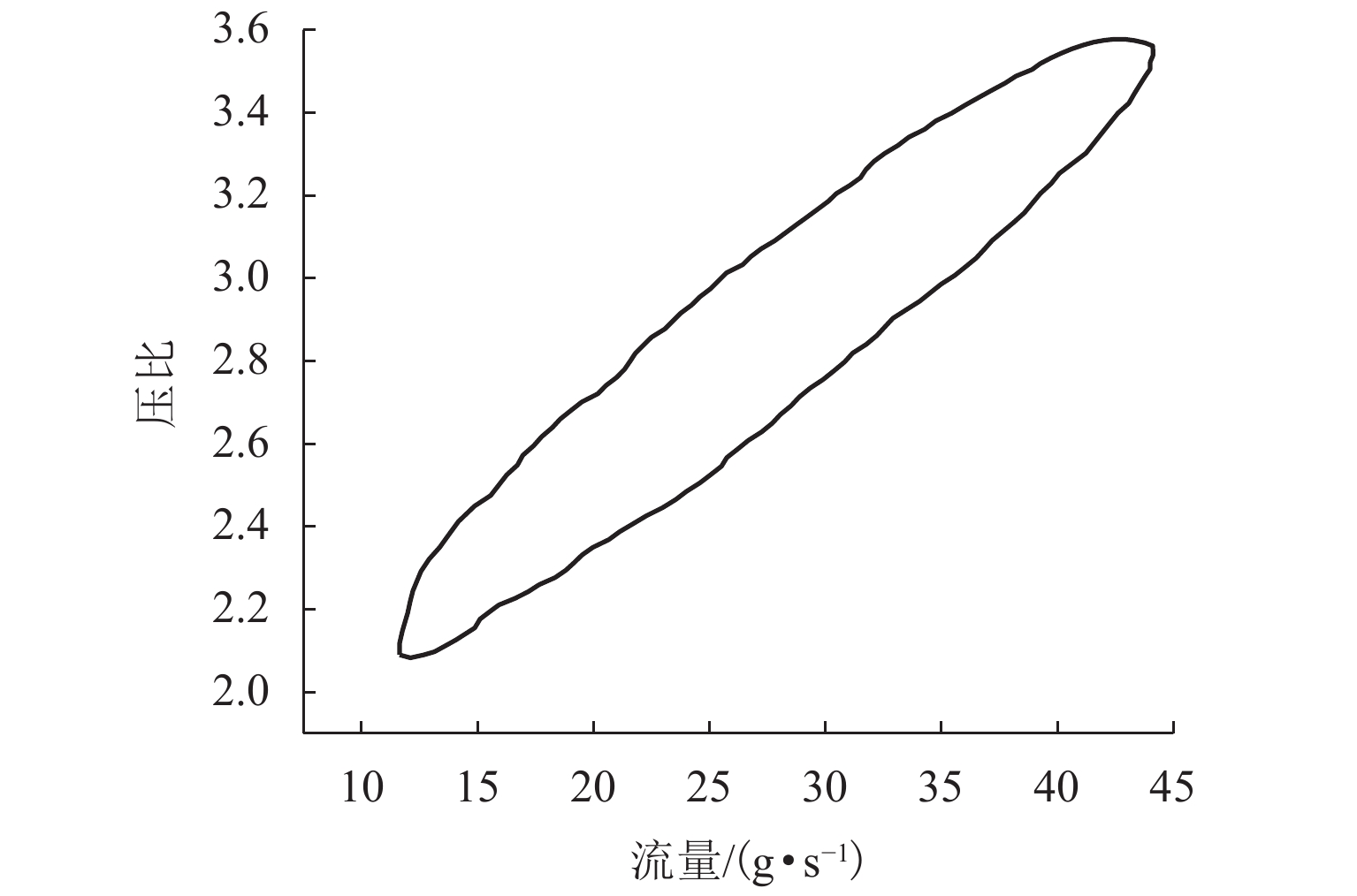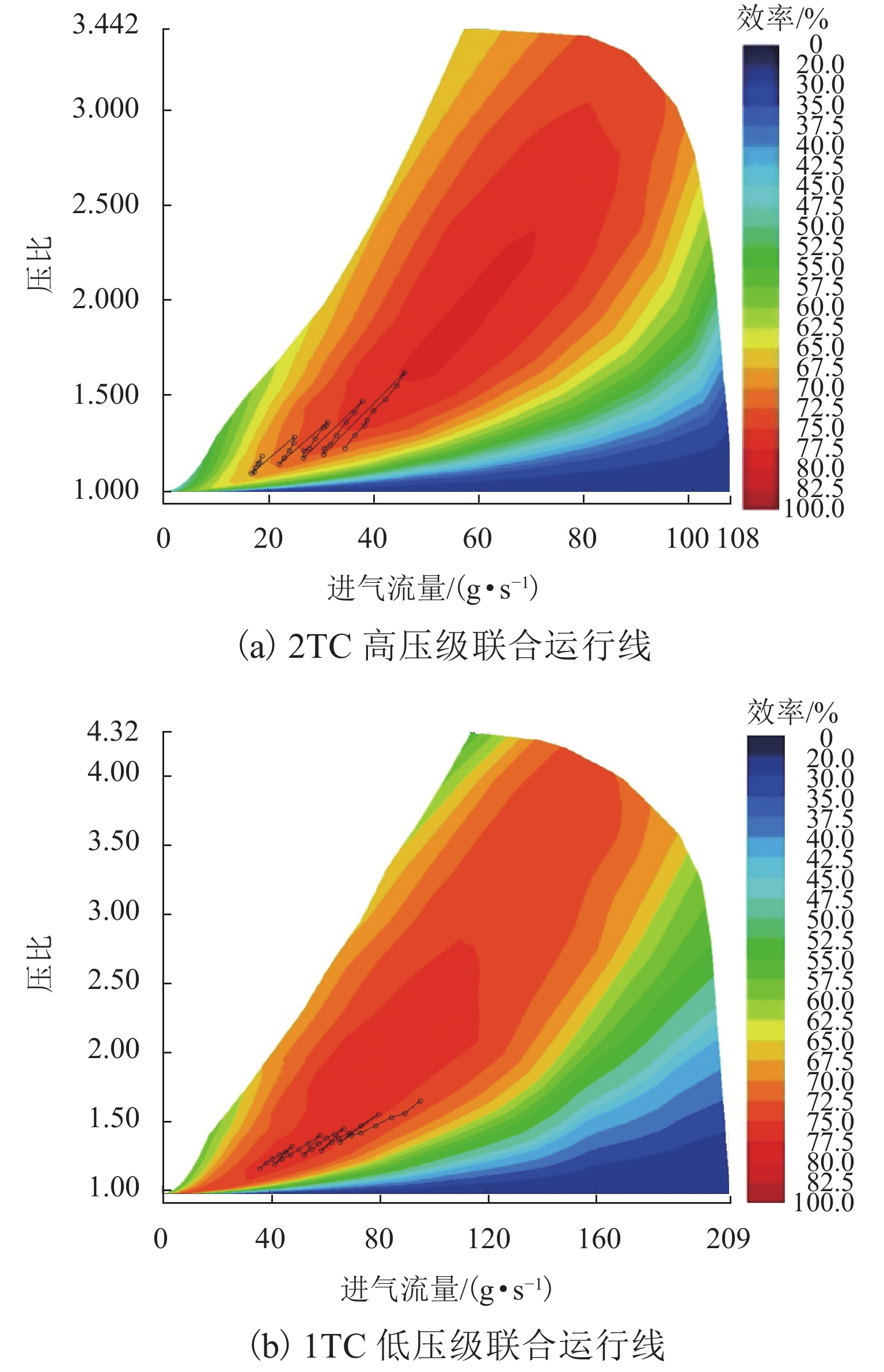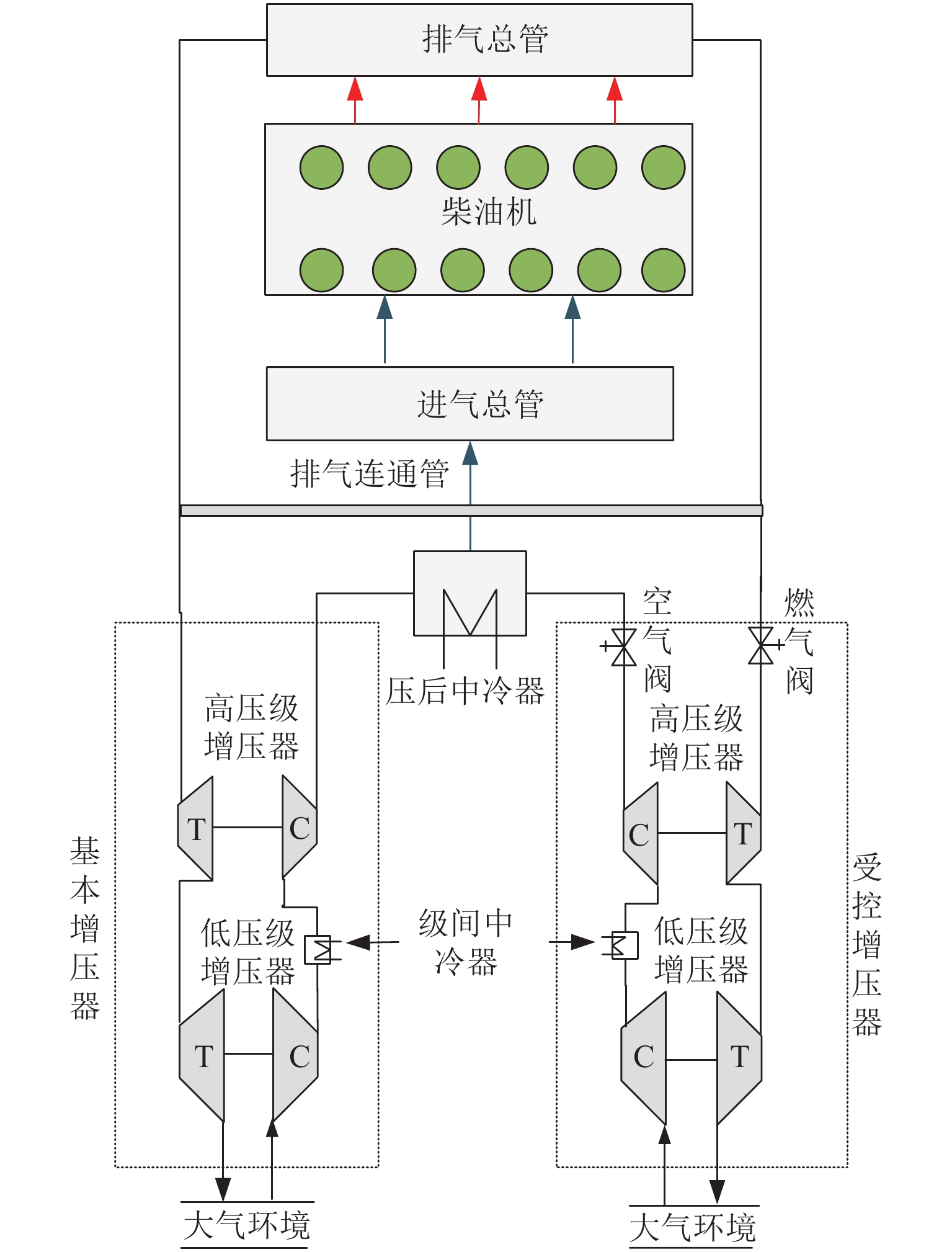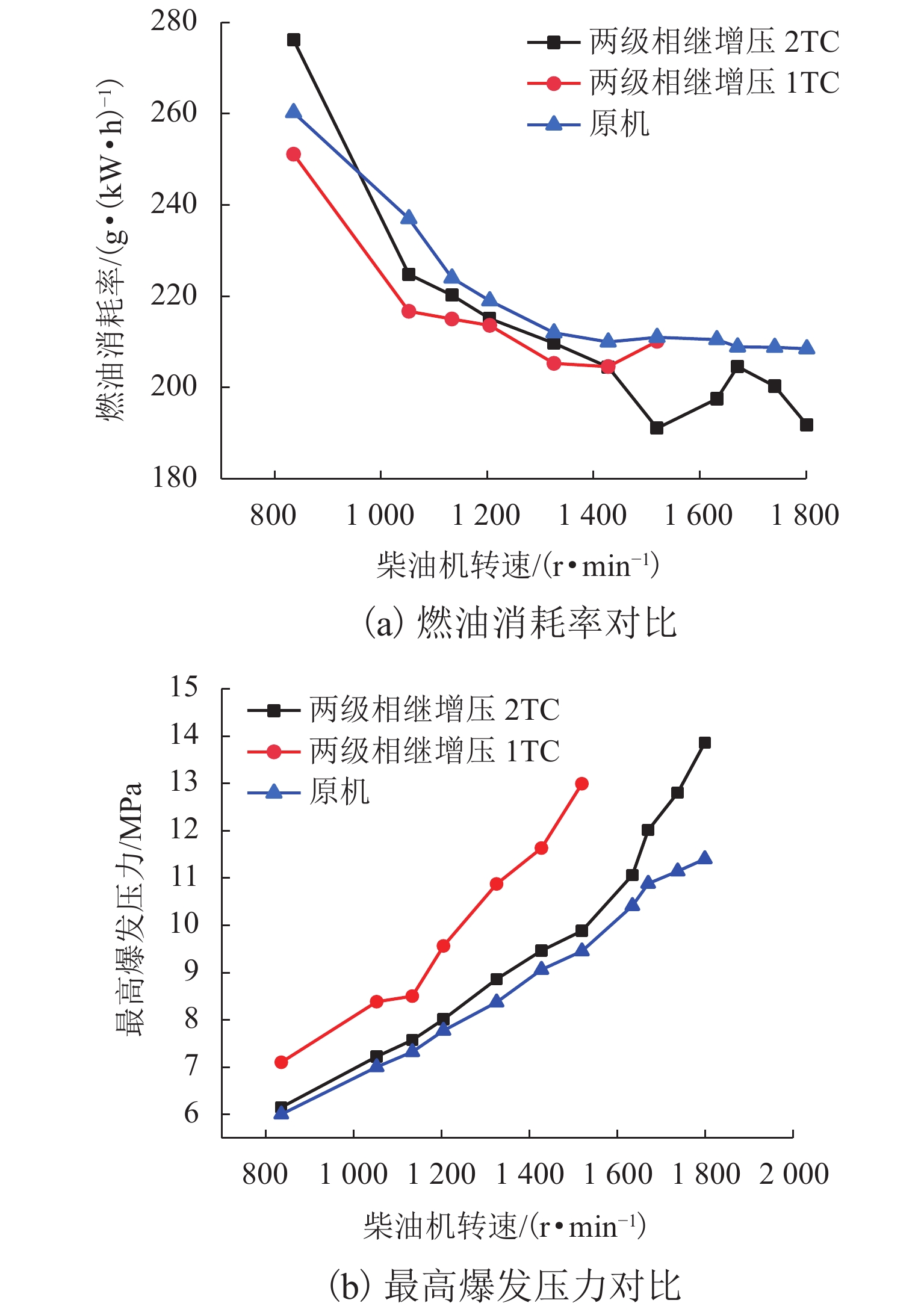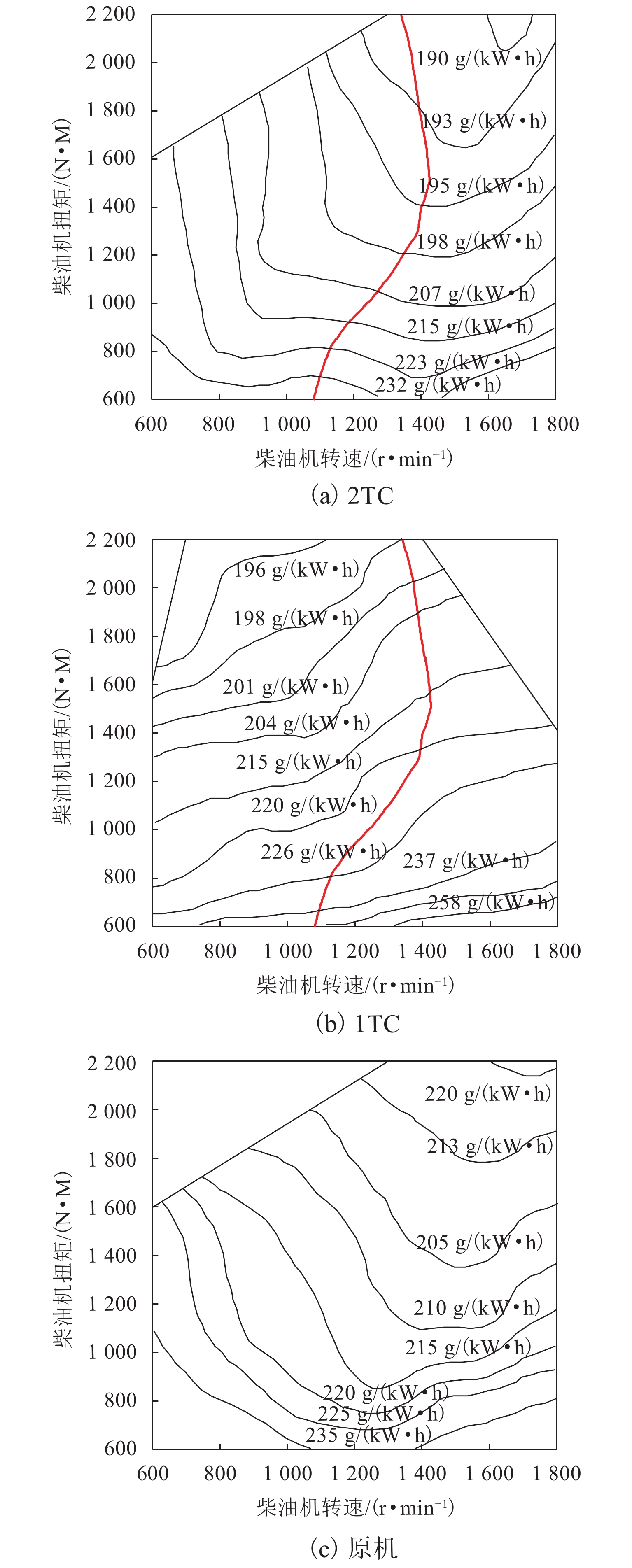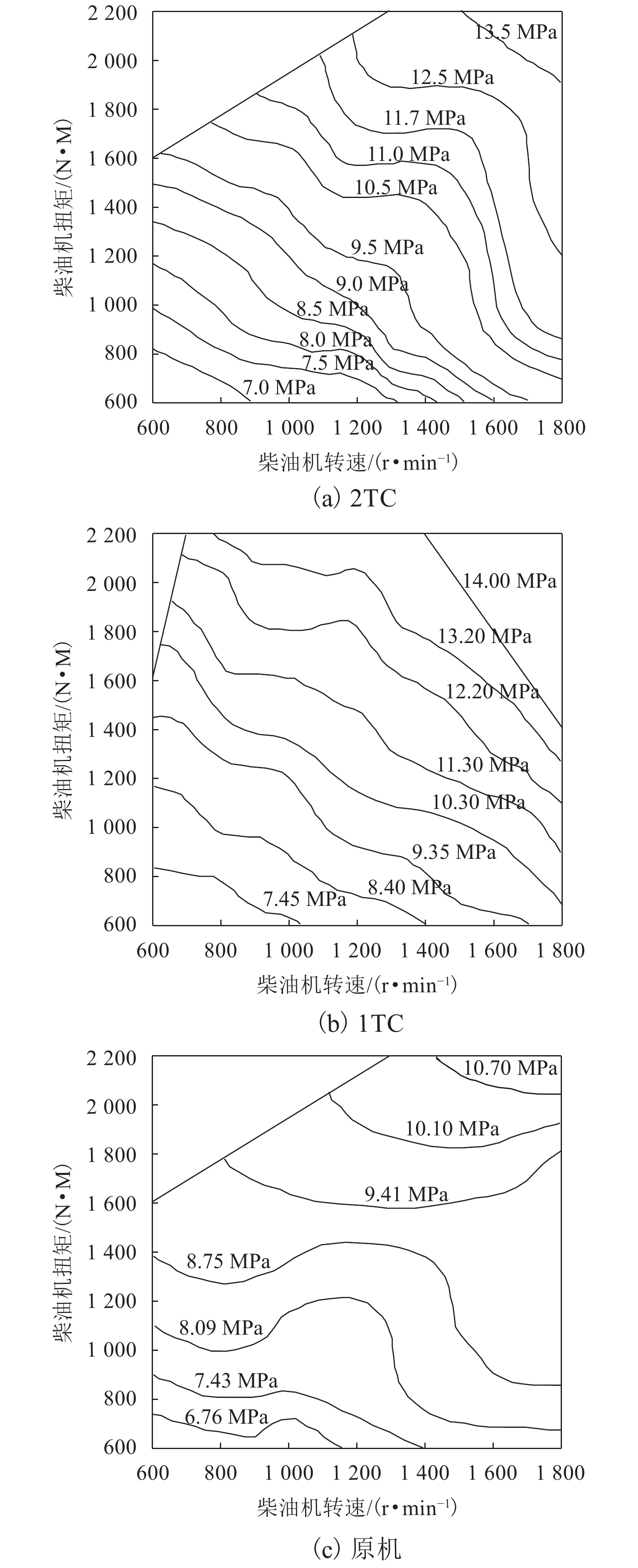Design and Matching Test of Two-Stage Sequential Supercharging System for Diesel Engines
-
摘要:
为改善低工况条件下因增压压力不足而造成柴油机缸内燃烧恶化问题,将两级增压(two-stage turbocharging,TST)与相继增压(sequential turbocharging,STC)技术相结合. 首先,通过推进特性试验进行两级相继增压与柴油机匹配计算,确定增压器型号;其次,利用GT-power软件得到增压器与柴油机联合运行曲线,验证方案的可行性;最后,进行台架试验,分析推进特性和负荷特性下两级相继增压对柴油机性能影响. 试验结果表明:推进特性条件下,在0~50%负荷区间,采用单涡轮增压(1TC)可以改善燃烧恶化问题;在50%~100%负荷区间,采用双涡轮增压(2TC)能够进一步提高空燃比,改善缸内燃烧,尤其在60%负荷下,燃油消耗率相比原机降低8.08%;两级相继增压模式在低转速、全扭矩及中高转速、高扭矩运行区域,可实现增压器的良好匹配.
Abstract:To improve the deterioration of combustion in the cylinder of diesel engines due to insufficient supercharging pressure under low operating conditions, two-stage turbocharging is combined with sequential turbocharging technology. First, the matching calculation of two-stage sequential turbocharging and diesel engine is carried out through propulsion characteristic tests, and the turbocharger model is determined. Secondly, the combined operation curve of the supercharger and diesel engine is obtained by using GT-power software to verify the feasibility of the scheme. Finally, the bench test is carried out to analyze the influence of two-stage sequential turbocharging on diesel engine performance under propulsion and load characteristics. The test results show that with propulsion characteristics, single turbocharging (1TC mode) can effectively improve the combustion deterioration under the engine load of 0–50%. Under the engine load of 50%–100%, the twin turbocharging (2TC mode) can further increase the air-fuel ratio and improve the in-cylinder combustion; especially at 60% engine load, the fuel consumption rate is 8.08% lower than that of the original engine. The two-stage sequential turbocharging mode can achieve good matching of turbochargers at low speed and full torque as well as medium-high speed and high torque.
-
Key words:
- diesel engine /
- two-stage sequential turbocharging /
- GT-power /
- supercharger matching
-
当前,随着日益严格的排放法规和材料技术的不断提升,柴油机正朝着高增压、低排放、高压比的方向发展,而增压技术的突破是实现上述目标的重要举措. 实现柴油机不同功能的增压技术应运而生,相继增压(sequential turbocharging,STC)技术在高负荷运行区域提供足够的增压压力和进气流量外,还通过减小增压器运行个数改善低工况增压器供气不足的状况. STC由德国MTU公司[1]于20世纪80年代在1163型号柴油机上率先使用. 改造后的柴油机整体性能得到大幅提升. 国内对STC研究起步较晚,哈尔滨工程大学王银燕教授[2]与407厂合作,对TBD620柴油机进行了STC改造,平均有效压力提高71%以上,油耗降低14%. 可调两级增压(two-stage turbocharging,TST)系统是将两个增压器串联,通过与旁通阀的配合使用,可以调节废气在高、低压级的分配,实现增压器与柴油机工况点的精准匹配. Schmitt[3]最早进行可调TST研究,完成D2842LE409柴油机的改造,有效改善了高负荷油气协同效果,最大扭矩提高51%. 在国内,北京理工大学最早进行TST研究,魏名山等[4]通过仿真软件完成了TST与柴油机的匹配,同时改造了可调TST系统台架,实现了进气量、过量空气系数、进气压力的匹配和高、低压比的合理分配.
高占斌等[5]在234V6型柴油机基础上,以降低NOx和Soot排放为目标,进行相继增压柴油机掺混生物柴油试验,结果表明,柴油机经过STC改造后,能有效弥补生物柴油造成的动力性下降和NOx升高. 李先南[6]以TBD234V12柴油机原机为依托,进行大小增压器STC系统设计,对比发现,当柴油机按标准螺旋桨特性运行时,采用大小增压器相继增压在低工况点可保证稳定的过量空气系数,能够有效改善经济性,降低热负荷. 但在双涡轮增压(2TC)、 60%~75%中高负荷区域,以及单涡轮增压(1TC)、10%~35%低负荷运行区域,增压效果并不明显. 吴鹏[7]在原机的基础上,利用GT-power软件建立柴油机模型,通过推进特性进行TST与柴油机匹配计算,确定了增压器型号. 采用TST,低负荷通过高、低压级增压器同时工作,增加进气压力,极大地改善了10%~35%负荷区域增压压力不足的状况,但高负荷时,TST进气压力下降幅度过大,导致某负荷处于最佳增压压力的柴油机在相近工况点出现进气压力不足,进而导致排温升高的情况. 为实现全工况范围内增压器与柴油机的良好匹配,本文将TST与STC相结合,并与柴油机进行匹配. 首先,将两级相继增压系统等效为两级增压系统,以额定工况为匹配点,求出两个有效涡轮当量截面积,在推进特性条件下,根据理论高、低压级压比分配,求出高、低级压气机耗气范围,进行压气机和涡轮的选配,选定合适的高、低压级增压器,左、右两列布置两组相同规格的大、小增压器;其次,将两级相继增压系统等效为相继增压系统,通过试验进行推进特性和负荷特性切换点选取;最后,经过对改造后的两级相继增压柴油机动力性、经济性和排放性与原机对比,验证匹配结果的可行性.
1. 增压器型号的选定
1.1 原机仿真模型建立与验证
利用GT-power软件建立原机一维模型,在试验数据的基础上,以缸内最高爆发压力、功率、燃油消耗率为校准点,以涡前温度、涡轮前后压力、NOx排放为限制条件,进行三韦伯燃烧模型校核. 三韦伯燃烧模型虽然没有精准的预测能力,但是通过对全工况范围内工况点进行燃烧模型校核,可以实现非校准工况点的准确计算. 应用GT-power软件建立原机单级增压系统一维仿真平台.
图1为原机推进特性条件下各参数仿真与试验值对比. 由图可知,NOx排放仿真与试验值最大偏差为3.02%,其他参数基本吻合,表明仿真模型具有一定的精度,可以用作后续的增压器匹配计算.
1.2 增压参数估算
增压器参数的确定一般有经验数据估算和公式计算两种 [8-9],单纯从经验数据进行增压器匹配,无法反映出空气流量与柴油机基本参数之间的内在联系,本文TST选配思路依据上海交通大学顾宏中教授的JTK (发动机与涡轮增压器匹配)方法[10-11],在TC系统的参数匹配基础上进行了补充.
首先,根据试验测得的高压级涡前废气温度,利用能量平衡公式[12]求出过量空气系数与扫气系数的乘积,如式(1)所示.
ξTHU−3 600geηm+αϕsL0(27.59 + 0.002 5Ts)Ts=(αϕs−1 + β0)L0fTTTH, (1) ξT=1.028−0.000 96D1.22np0.22s√αgeηmT1.5sv0.78m×(0.5+0.5D/S), (2) fT=8.315 + 20.47 + 2.51(αϕs−1)1000αϕsTTH, (3) 式中:
ξT 为涡轮前排气能量利用系数;HU为燃料低热值,kJ/kg;ge为有效燃油消耗率,g/(kW·h);ηm 为机械效率;α 为过量空气系数;ϕs 为扫气系数;L0为理论燃烧1 kg柴油所需空气量,取值为14.3 kg;Ts为柴油机进气管中空气温度,K;β0 为燃烧后理论摩尔变化系数;fT为废气平均定压摩尔热容,kJ/(mol·K);TTH为高压级涡前度气温度,K;D为气缸直径,mm;n为转速,r / min;ps为增压压力,MPa; vm为活塞平均速度,m/s; S 为活塞冲程,mm.据此建立目标工况与空气流量
mk 之间的关系式:mk=Neogeoαϕs3 600L0, (4) 式中:Neo为匹配目标功率值,kW;geo为目标燃油消耗率,g/(kW·h).
利用式(1)得出的
αϕs 计算耗气量为mT=ηvϕsn60C1000psRTsiVs, (5) 式中:
ηv 为容积效率;C为冲程系数,四冲程取值为4;R为气体常数,8.314 J/(mol·K);i为发动机缸数,取值为12;Vs为气缸工作容积,m3.令耗气量与空气流量相等,将
Neo=iVspen61.2C 代入式(4),联立式(5),得到高压级压气机出口压力为pKH=αL0peTsgeR878ηv + Δp. (6) 式中:pe为压缩终点压力,MPa;
Δp 为中冷过程进气压力降低值,0.003~0.005 MPa设计时,以压气机耗功最小为原则进行压比分配. 低、高压级压气机耗功分别如式(7)、(8)所示.
WCL=kCLkCL−1RgTL[(pH+ΔppL)kCLkCL−1−1]/ηTKL, (7) WCH=kCHkCH−1RgTH[(pKHpH)kCHkCH−1−1]/ηTKH, (8) 式中:WCL、WCH分别为高压级压气机耗功,kW;kCL、kCH分别为低、高压级压气机压缩过程的气体比热比;
ηTKL 、ηTKH 分别为低、高压级增压器综合效率;Rg为摩尔气体常数,387.1 J/(kg·K);TL为大气温度,K;pL为大气压力,MPa;pH为高压级压气机进气压力,MPa;TH为高压级出口温度,K.经过级间冷却后,假设高、低压机入口温度、效率及压缩指数均相等. 令总压缩功对
pH 进行求导,并等于0,经过化简,得到增压器高、低压级压比约为1∶1,由此可以得到高、低压级等价关系如式(9)所示.pKLpL=pKHPKL−0.003, (9) 式中:pKL为低压级压气机出口压力,MPa.
低压级涡轮前排气平均压力可由压气机与涡轮的功率平衡关系式计算得出,如式(10)所示.
ηTKLmT75kTkT−1RTTTL[1−(pTLpL+0.3)−kTkT−1]=3.5mk75RTL[(pKLpL)3.5−1], (10) 式中:kT为气体比热比,取1.33;TTL为低压级涡前废气温度,K;pTL为低压级涡轮前排气平均压力,MPa.
高、低压级涡轮间理论流量mTH、mTL表示为
mTH=mTL=mT. (11) 高压级涡轮与增压器的功率平衡关系式:
pKHpKL=[181−3.5kTHkTH−1mTmkTTHTKLηTKH((pTLpTH)kTH−1kTH−1)]kTHkTH−1, (12) 低压级涡轮与增压器的功率平衡关系式:
pKLpL=[181−3.5kTLkTL−1mTmkTTLTLηTKL((pLpTL)kTL−1kTL−1)]kTLkTL−1, (13) 式(12)、(13)中:kTH、kTL分别为高、低压级涡轮前气体比热比;TKH、TKL分别为高、低压级压气机入口温度,K;pTH为高压级涡轮入口平均压力,MPa;TTL为低压级涡轮入口温度,K.
联合求解式(12)、(13),可求出低压级涡轮入口温度TTL[13]. 结合压气机与涡轮的功率平衡关系(式(14))计算高压级涡轮入口平均压力pTH.
ηTKHmT75kTkT−1[1−(pTHpTL)−kTkT−1]RTTTH=3.5mk75RTKH[(pkHpKL)3.5−1], (14) 式中:RT为废气摩尔气体常数,396.5 J/(kg·K).
根据理想气体状态方程(式(15)、(16)),可分别求出低压级和高压级涡轮前气体密度
ρTL 和ρTH .PTL = ρTLRTTTL, (15) PTH = ρTHRTTTH. (16) 在涡前废气质量流量、涡前压力和温度已知的条件下,定义高、低压级涡轮当量截面积
μTHFTH 、μTLFTL 分别如式(17)、(18)所示[14],FTH、FTL分别为高、低压涡轮截面积,m2,μTH 、μTL 分别为高、低压级涡轮流量系数.μTHFTH=mTψTHρTH√2RTTTH, (17) μTLFTL=mTψTLρTL√2RTTTL, (18) ψTL=√kTkT−1[(pLpTL)2/kT−(pLpTL)(kT + 1)/kT], (19) ψTH=√kTkT−1[(pLpTH)2/kT−(pLpTH)(kT + 1)/kT], (20) 式中:
ψTL 、ψTH 分别为低、高压级涡轮流函数.1.3 选定方案
在柴油机额定工况下,根据柴油机运行参数和结构参数为基础,求出高、低压级涡轮当量截面积
μTHFTH 、μTLFTL ,具体流程如图2所示.在涡轮流通面积基础上,通过计算推进特性条件下柴油机与增压器整机联合运行流量和压比,进一步提高选型精度. 假设功率不变的条件下柴油机推进特性运行曲线不发生改变,由于增压器的改变,过量空气系数也随之变化,因此,选定过量空气系数变化范围为1.5~2.5,在转速和油耗不变的条件下可以计算出整个增压系统压比和流量变化范围,如图3所示. 根据式(9)计算出的高、低压理论压比得出推进特性下不同工况点高、低压级压气机耗气范围,进而实现压气机匹配.
为保证精度的前提下缩小选型范围,在两台并联布置的原J100增压器的基础上,将计算结果同增压器厂提供的同系列J型号增压器进行比较,确定最终型号. 选型的标准为:在高负荷运行区域,所有工况点均处于压气机高效运行区,同时保证2TC低工况点有足够的喘振裕度,并且远离堵塞线.
1.4 增压器匹配仿真结果
将计算获得的涡流面积以及强化后柴油机推进特性下耗气特性与原机增压器同系列参数进行比较,最终确定高压级增压器型号为JP100K,低压级增压器型号为J130S. 将上述两种型号增压器转速、效率和压比等相关数据(MAP图)导入建立的原机模型中,完成两级相继增压柴油机模型的构建,进行推进特性和负荷特性仿真模拟,结果如图4、5所示. 由图可知,在推进特性和万有特性运行条件下,无论是1TC还是2TC模式,柴油机运行工况点均处在压气机高效率运行区域内,并且有充足的喘振裕度. 因此,可以以此增压器型号与柴油机匹配,进行试验验证.
2. 两级相继增压系统匹配试验分析
2.1 实验台架改造及方案
柴油机基本设计参数如表1所示. 本文研究的两级相继柴油机是将每列布置的一台J100增压器改为大小涡轮串联的两级增压器. 低、高压级增压器型号分别为J130S和JP100K. 在一列的进气管与排气管上分别布置空气阀与燃气阀,用于控制1TC与2TC之间的切换,改造后的增压系统如图6所示. 试验使用涡流式水力测功机,缸压传感器型号为Kistler6125C,角标仪、燃烧分析仪均由AVL公司生产.
表 1 柴油机主要技术参数Table 1. Main technical parameters of diesel engine参数 参考值 标定功率/kW 444 标定转速/(r·min−1) 1800 气缸排列方式 V 型,60° 夹角 缸径/mm 128 冲程/mm 140 排量/L 28.8 压缩比 15∶1 发火次序 参考文献[6] 增压器型号 J100 整体试验思路为:以增压器转速、最高爆发压力、排气温度为限制条件逐渐增加功率,柴油机分别在1TC (受控增压器列关闭)与2TC (受控增压器列开启)模式下完成推进特性和负荷特性试验. 推进特性条件下,10%~60%运行区间选用1TC,10%~100%运行区间选用2TC.
负荷特性是从600 r/min的转速下从0开始加载,保持转速不变,通过测功机逐次增加负荷,间隔为200 N·M,在满足所有限制性指标条件下,得到指定转速下负荷特性的所有工况试验数据. 转速间隔为100 r/min,最高转速1800 r/min.
2.2 推进特性试验
以燃油消耗率作为相继增压切换点的主要参考指标,由图7(a)中1TC与2TC模式下燃油消耗率曲线对比发现,在低工况,1TC模式下燃油消耗率整体低于2TC,高工况反之. 因此,推进特性下将50%工况点作为相继增压的切换点. 柴油机在1TC和2TC模式下,燃油消耗率均低于原机,尤其自切换点开始,2TC模式下燃油消耗率的降低尤为明显. 在60%负荷下,燃油消耗率为 181.5 g/(kW•h),相比原机降低8.08%. 因为60%负荷时,原机增压器与柴油机匹配度不佳,进气压力过低,而在2TC两级增压模式下,中高负荷范围内能够满足缸内正常燃烧所需空燃比,进而降低燃油消耗率. 在90%负荷下,2TC模式下燃油消耗率相比原机变化最小,原因在于,90%负荷为柴油机主要运行工况点,原增压器选配是以此作为设计工况点进行选配,缸内燃料可以获得充分燃烧. 因此,在此工况点两级相继增压对柴油机可优化程度较低,燃油消耗率变化不大.消耗率变化不大.
从图7(b)不难发现,1TC、2TC模式下缸内最高爆发压力均高于原机. 在2TC模式下,负荷低于70%时,缸内最高爆发压力与原机差距较小,但在较高负荷区域差距明显增加,最高爆发压力相比原机最高增加20%,同时最高爆发压力13.8 MPa,没有超过压力限制值(14.5 MPa). 由此可知,2TC模式对柴油机低负荷区域燃烧并没有得到改善,但在高负荷区域,尤其是额定工况附近,2TC模式结合两级增压能够极大地增加进气密度,改善缸内燃烧. 在1TC、低负荷区域,缸内最高爆发压力明显高于原机. 柴油机在低负荷区域工作,废气流量本身较低,单列增压器工作更有助于提高涡轮背压,同时,相继增压的改造使得单个增压器型号明显小于原机,低工况点的废气压力和流量能够位于涡轮高效运行区,空气在两级增压器的连续提升下,进气压力获得进一步提高,使得低工况的进气压力能够满足缸内燃烧,与只针对高工况点设计的原机增压器相比,两级相继增压的改造,更有助于低工况的燃烧.
2.3 负荷特性试验
1TC、2TC模式与原机的等燃油消耗率曲线如图8所示. 从图中不难发现,改进后的增压系统对应燃油消耗率均明显低于原机. 在高转速高扭矩范围内,相邻工况点等值线递减程度比原机更加平稳,平均燃油消耗率比原机减少约10 g/(kw·h). 同时,在低转速、较高扭矩范围内,1TC增压模式燃油消耗率明显低于原机与2TC相继增压模式,1TC、20%负荷有效燃油消耗率比原机降低8.21%. 这说明,1TC相继增压模式下的增压能力能够满足低转速条件下柴油机从低到中高负荷所需进气压力. 相较于1TC,2TC两级增压模式在低扭矩经济性略高于原机,这是因为低负荷条件下,2TC模式两列增压器并联,涡前压力和流量均处于增压器低效率区,增压能力得不到体现.
对于负荷特性条件下切换点的确定,是通过将1TC、2TC条件下燃油消耗率面工况做差得到一条差值为0的边界线,如图8(a)所示. 图中:红线表示负荷特性条件下1TC-2TC的切换线; 红线左侧区域表示1TC两级增压模式,此时对应燃油消耗率低于2TC;与之相反,红线右侧区域表示2TC两级增压模式.
等最高爆压曲线如图9所示,对比图7(b)和图9不难发现,1TC模式对应工况点缸内最高爆发压力高于原机,2TC次之;在1TC低转速低扭矩范围内,相邻工况点等值线递减程度比原机更加平稳,说明1TC相继增压模式能够实现柴油机低转速低扭矩工作范围合理匹配. 2TC模式在高转速高扭矩运行区域内,相比原机同样更加稳定,说明2TC相继增压模式能够实现柴油机高转速、高扭矩范围最佳空燃比.
3. 结 论
1) 在已校准的原机模型基础上利用简化的涡轮增压器,实现推进特性工况目标功率的优化,通过仿真结果计算高、低压级涡轮流通面积,结合柴油机与增压器整机联合运行流量和压比MAP图,为增压器的选型提供充足的理论支撑.
2) 将初步选定的增压器MAP图谱导入GT-power柴油机模型,完成了推进特性和负荷特性的各个匹配设计点工况的联合运行.
3) 实现了全工况STC切换点的选取,在低转速中低负荷区域,采用1TC可以避免原机增压器尺寸过大、增压压力不足的问题,20%负荷燃油消耗率比原机降低8.21%;在高负荷尤其是中高负荷区域,两级相继增压模式可以实现与原机的合理匹配,在60%负荷燃油消耗率181.5 g/(kW·h),比原机下降8.08%,经济性和动力性均得到明显改善.
-
表 1 柴油机主要技术参数
Table 1. Main technical parameters of diesel engine
参数 参考值 标定功率/kW 444 标定转速/(r·min−1) 1800 气缸排列方式 V 型,60° 夹角 缸径/mm 128 冲程/mm 140 排量/L 28.8 压缩比 15∶1 发火次序 参考文献[6] 增压器型号 J100 -
[1] WINTRUFF I, BÜCHELER O, RALL H, et al. The new MTU series 4000 rail engines certified for EU IIIB[J]. MTZ Worldwide, 2011, 72(5): 30-34. doi: 10.1365/s38313-011-0050-0 [2] 王银燕,何清林,王贺春,等. 柴油机采用4台增压器相继增压性能的试验研究[J]. 内燃机工程,2012,33(1): 6-10,17. doi: 10.3969/j.issn.1000-0925.2012.01.002WANG Yinyan, HE Qinglin, WANG Hechun, et al. Experimental research on performance of four-turbocharger sequential turbocharged diesel engine[J]. Chinese Internal Combustion Engine Engineering, 2012, 33(1): 6-10,17. doi: 10.3969/j.issn.1000-0925.2012.01.002 [3] SCHMITT F. Powerful turbocharging system for passenger car diesel engines[J]. MTZ Worldwide, 2014, 75(3): 12-19. doi: 10.1007/s38313-014-0028-9 [4] 魏名山,张志,方金莉,等. 带有放气阀的二级增压系统的设计与试验[J]. 内燃机学报,2009,27(2): 166-170. doi: 10.3321/j.issn:1000-0909.2009.02.012WEI Mingshan, ZHANG Zhi, FANG Jinli, et al. Design and experiments for a regulated two-stage turbocharging system with a wastegate valve[J]. Transactions of CSICE, 2009, 27(2): 166-170. doi: 10.3321/j.issn:1000-0909.2009.02.012 [5] 高占斌,王彬彬,高敬博,等. 掺混生物柴油对相继增压柴油机燃烧性能的影响[J]. 西南交通大学学报,2022,57(4): 791-796. doi: 10.3969/j.issn.0258-2724.20200544GAO Zhanbin, WANG Binbin, GAO Jingbo, et al. Emission characteristics of successively supercharged diesel engine blended with biodiesel[J]. Journal of Southwest Jiaotong University, 2022, 57(4): 791-796. doi: 10.3969/j.issn.0258-2724.20200544 [6] 李先南. 船用V型柴油机大小增压器相继增压系统设计研究[D]. 哈尔滨: 哈尔滨工程大学, 2012. [7] 吴鹏. 柴油机米勒循环与两级涡轮增压的研究[D]. 哈尔滨: 哈尔滨工程大学, 2013. [8] 刘博. 柴油机可调二级涡轮增压系统研究[D]. 上海: 上海交通大学, 2011. [9] 钱跃华. 双涡轮增压系统匹配方法和优化控制的研究[D]. 上海: 上海交通大学, 2015. [10] 顾宏中. 涡轮增压柴油机性能研究[M]. 上海: 上海交通大学出版社, 1998: 7-14. [11] 顾宏中,郭中朝. 16VPA6STC柴油机改用MIXPC涡轮增压系统研究[J]. 中国造船,2008,49(1): 90-96. doi: 10.3969/j.issn.1000-4882.2008.01.014GU Hongzhong, GUO Zhongchao. A study of MIXPC turbocharging system on 16VPA6STC diesel engine[J]. Ship Building of China, 2008, 49(1): 90-96. doi: 10.3969/j.issn.1000-4882.2008.01.014 [12] LENG L, QIU H J, LI X N, Et al. Effects on the transient energy distribution of turbocharging mode switching for marine diesel engines[J]. Energy, 2022, 249: 123746.1-123761.11. [13] LIU R L, YANG C H, ZHANG Z J, et al. Experimental study on thermal balance of regulated two-stage turbocharged diesel engine at variable altitudes[J]. Journal of Thermal Science, 2019, 28(4): 682-694. doi: 10.1007/s11630-019-1151-3 [14] WANG J, SHEN L Z, BI Y H, et al. Power recovery of a variable nozzle turbocharged diesel engine at high altitude by response surface methodology and sequential quadratic programming[J]. Proceedings of the Institution of Mechanical Engineers, Part D: Journal of Automobile Engineering, 2019, 233(4): 810-823. doi: 10.1177/0954407017753913 期刊类型引用(0)
其他类型引用(2)
-






 下载:
下载:




















































 下载:
下载:










